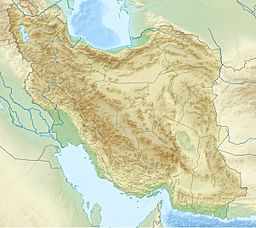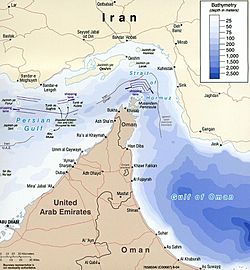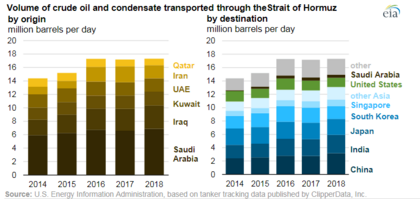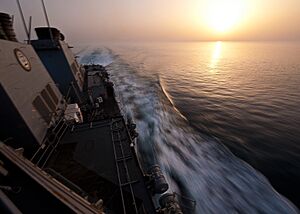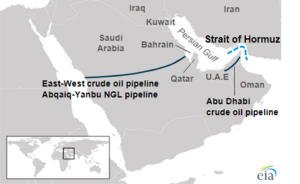Strait of Hormuz facts for kids
Quick facts for kids Strait of Hormuz |
|
|---|---|
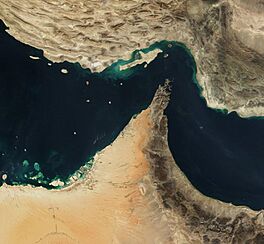
A satellite image of the Strait of Hormuz.
|
|
| Location | Persian Gulf–Gulf of Oman |
| Coordinates | 26°36′N 56°30′E / 26.6°N 56.5°E |
| Type | Strait |
| Native name | |
| Basin countries | Iran, Oman, United Arab Emirates |
| Min. width | 21 nmi (24 mi; 39 km) |
| Islands | Hormuz Island Qeshm Island |
| Settlements | |
The Strait of Hormuz is a narrow waterway that connects the Persian Gulf to the Gulf of Oman, which then leads to the open ocean. It is one of the world's most important sea passages and is often called a strategic choke point. A choke point is a narrow channel that ships must pass through, making it a very important spot for global trade.
On the north coast of the strait is Iran. On the south coast is the Musandam peninsula, which is shared by the United Arab Emirates and an exclave of Oman (a piece of a country separated from its main part). The strait is about 104 miles (90 nmi; 167 km) long and its width changes from about 60 mi (52 nmi; 97 km) to 24 mi (21 nmi; 39 km).
A huge amount of the world's energy supply passes through this strait. About one-third of the world's liquefied natural gas and about 20% of the world's total oil travels through it on large ships called tankers. This makes the Strait of Hormuz extremely important for the global economy.
Contents
Where the Name Comes From
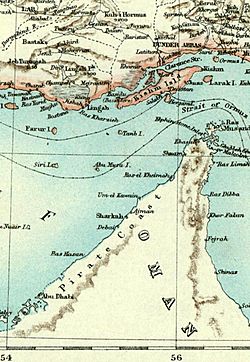
The name "Hormuz" might have come from a few different places.
- One theory is that it was named for Ifera Hurmiz, the mother of a Persian king named Shapur II, who ruled in the 4th century.
- Another idea is that the name comes from the local Persian word Hur-mogh, which means "date palm."
- The name also sounds like Hormoz, a god in the ancient Zoroastrian religion.
In the past, a powerful trading kingdom called the Kingdom of Ormus was located here, and it likely gave the strait its name.
To prevent ships from colliding in the narrow waterway, there is a Traffic Separation Scheme (TSS). This works like a highway on the ocean.
- Ships going into the Persian Gulf use one lane.
- Ships leaving the Persian Gulf use another lane.
- Each lane is two miles wide, and they are separated by a two-mile-wide median.
To pass through the strait, ships travel through the waters of both Iran and Oman. International rules, like the United Nations Convention on the Law of the Sea (UNCLOS), help make sure that ships from all countries can pass through safely. Oman has a radar station on an island to help monitor the ship traffic and keep things running smoothly.
Why the Strait Is So Important
The Strait of Hormuz is a vital link in the world's energy supply chain. In 2018, about 21 million barrels of oil passed through the strait every single day. That's equal to over a billion dollars' worth of oil daily.
Most of this oil goes to countries in Asia, such as China, Japan, India, and South Korea. Because so much of the world's energy depends on this single, narrow passage, any disruption or blockage in the strait could have a major impact on the global economy and oil prices. This is why many countries consider keeping the strait open to be very important.
A History of Tensions
Because the strait is so important, it has often been a center of political and military tension.
The Tanker War
During the Iran–Iraq War in the 1980s, Iraq began attacking oil tankers leaving Iran. Iran then attacked ships connected to Iraq. This phase of the war became known as the "Tanker War." Even with these attacks, the strait itself was never closed to shipping.
The United States Navy and other navies often patrol the area to protect shipping. This has sometimes led to tense situations and tragic accidents.
- Operation Praying Mantis: In 1988, the U.S. military attacked Iranian naval ships and oil platforms. This was in response to an American warship being damaged by an Iranian naval mine.
- Iran Air Flight 655: On July 3, 1988, a U.S. Navy warship, the USS Vincennes, shot down an Iranian passenger airplane over the strait. All 290 people on board were killed. The U.S. government stated that the crew of the warship mistakenly thought the passenger plane was an attacking fighter jet.
- Collisions: The strait is a very busy waterway. There have been several accidental collisions, including one in 2007 between a U.S. nuclear submarine and a large Japanese oil tanker, and another in 2009 between a U.S. submarine and another U.S. naval ship.
Threats to Close the Strait
Over the years, Iran has sometimes threatened to close the Strait of Hormuz. These threats often happen during times of political disagreement, such as when other countries place economic sanctions (financial penalties) on Iran.
In response, countries like the United States, the United Kingdom, and France have said they would use their navies to keep the strait open. They have sent warships to the region to show they are serious about protecting international trade. So far, the strait has never been fully closed.
Seizing Ships
In recent years, Iranian forces have sometimes boarded and seized commercial ships passing through or near the strait.
- In 2019, Iran captured a British-flagged oil tanker, the Stena Impero.
- In 2024, Iranian forces seized a container ship named MSC Aries.
These events often happen during periods of high tension and create uncertainty for international shipping companies.
Can Iran Block Shipping?
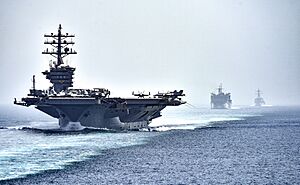
Because the strait is so narrow, Iran could make shipping difficult or dangerous. It could use naval mines, fast attack boats, or missiles to threaten ships.
However, many other powerful countries, especially the United States, have a strong military presence in the area. Military leaders from the U.S. have said that they have the ability to reopen the strait if it were ever blocked. The fact that the strait is both easy to disrupt and vital to the world economy is why it remains a major point of tension in world politics.
Finding Other Routes
To reduce the risk of relying completely on the Strait of Hormuz, some countries have built pipelines to create alternative routes for their oil.
- The United Arab Emirates built the Habshan–Fujairah oil pipeline, which carries oil from its fields across the country to the Gulf of Oman. This route completely bypasses the Strait of Hormuz.
- Saudi Arabia has also reopened a pipeline that can carry oil from Iraq to a port on the Red Sea.
These pipelines help ensure that oil can continue to flow to the rest of the world, even if there are problems in the strait.
See also
 In Spanish: Estrecho de Ormuz para niños
In Spanish: Estrecho de Ormuz para niños
- Abu Musa island
- Bandar Lengeh
- Hormozgān Province
- Kingdom of Hormuz
- Musandam Peninsula
- Hormuz Peace Initiative


